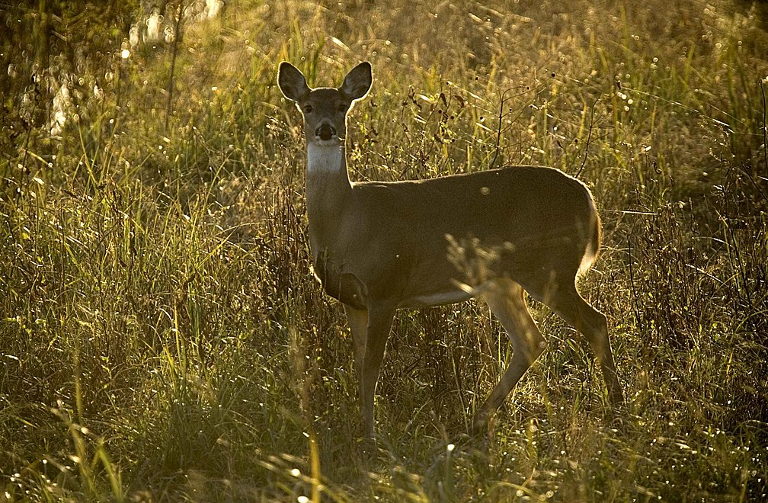As a non-hunting, vegetarian nature-lover I am in favor of deer. My heart lifts when I see a doe and fawn browsing in the green dappled light of early summer in Thatcher Woods. I marvel at their ability to move quickly through the trees and to seemingly appear and disappear at will. Yet I believe that deer herds should be managed so that their population will fit the available habitat.
In the natural, food-webby scheme of things, deer, as herbivores, are prey animals with high reproductive rates and a need for large areas full of the plants that nourish them. Over the past million years they’ve co-evolved with their predators; until the 19th century, deer roamed widely, their populations kept in balance by the wolves and Native peoples who depended on them for sustenance. Wolves took what they needed and left the rest for scavengers such as coyotes and crows. Humans used nearly every part of the deer–meat, hide, hooves, bones, and antlers—to supply an extremely sustainable, low-waste lifestyle. Deer herds were healthier and plant bio-diversity was high.
When settlers occupied Illinois, breaking the prairies, felling timber, and building cities and railroads, everything changed. They extirpated the wolves and drove out the Native tribes. Deer hunting continued until the population crashed, and hunting was banned between 1901 and 1957. In the Chicago region hunting ceased altogether while habitat shrank. With no predators besides the coyotes that reappeared in the late 1970’s, urban deer kept multiplying, foraging for plants, and dying from starvation and sickness, while severely damaging bio-diverse ecosystems—and people’s gardens.
Like it or not, we are now the apex predators. Because we manage the land and its creatures, I believe we have the responsibility to do so in an ecologically beneficial manner. We’re not about to tear down our neighborhoods and move away so deer can have more habitat. Nor is the thought of wolves roaming Thatcher Woods enticing. So, what are the choices? All management must be an ongoing process because deer will always reproduce maximally in response to population decline, no matter the cause. Birth control and other methods are logistically difficult and extremely expensive. Alternatively, professional sharpshooters can cull the herds efficiently at regular intervals—with the processed meat provided to charities.
A smaller herd would give each fawn a greater chance to grow up healthy. Bio-diversity would increase and the beautiful wildflowers, shrubs, and trees native to our woods would thrive. Starving animals would not wander the streets, endangering motorists and themselves. Realistically, the deer in a well-managed herd would live more natural lives than the animals in our industrial agriculture system. Deer are not our pets. Nor are they pests. They are wild animals trying to live their lives in the context of their biological roles, within a human dominated landscape. We humans have the responsibility to make sure they can do so, in order that they and we can beneficially co-exist.
Note: Just as in people’s gardens, deer browsing reduces the abundance of flowers in woodlands, which helps contribute to the decline of native bees. “Spring forest flowers likely a key to bumble bee survival, Illinois study finds”
This piece was originally published on March 30, 2021 in the Oak Park Wednesday Journal.
Teaser photo credit: By Hillebrand Steve, U.S. Fish and Wildlife Service – http://www.public-domain-image.com/public-domain-images-pictures-free-stock-photos/fauna-animals-public-domain-images-pictures/deers-public-domain-images-pictures/white-tailed-deer-pictures/white-tailed-doe-odocoileus-virginianus-standing-alertly-in-low-brush-and-looking.jpg, Public Domain, https://commons.wikimedia.org/w/index.php?curid=24857028






